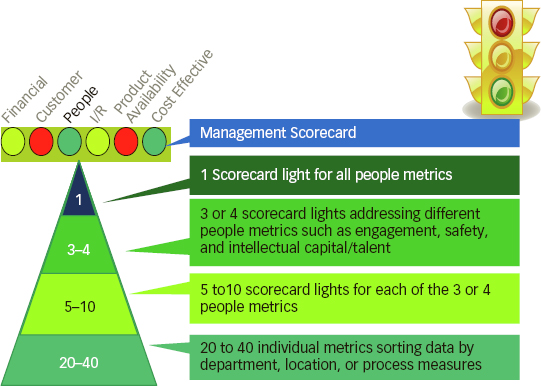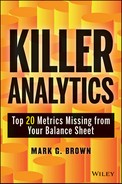Preface
Leaders need a constant stream of information to steer their organizations down a path of success. Being able to detect little problems or challenges before they escalate into bigger ones is a key requirement for managing organizational performance.
Too many managers today rely on anecdotal data or no real data at all, with only lagging financial and operational measures to look at to see how things are going. This book is not about measuring financial performance. There are plenty of books about that. It is rare that I encounter an organization that does not have good solid operational and financial metrics. This book is about measuring the stuff that most organizations struggle with. The ultimate goal in most organizations is financial success: growth, profits, share price, and return on investment are certainly important, but many other things are prerequisites to achieving those financial goals. Reviewing financial and operational performance against targets is extremely important. However, the root causes of failures or missing your financial targets are usually other dimensions such as dissatisfied customers, unhappy employees, external factors, poorly performing suppliers, legal and regulatory issues, or failure to bring in quality new customers.
KEY QUESTIONS
This book is about how to develop composite or analytic metrics that provide answers to the following questions that cause sleepless nights for leaders:
- Are we encouraging our people to develop innovative products, processes, and services?
- Are we effectively managing our supply chain and maintaining good relationships with suppliers and partners?
- Are we performing well on key corporate projects and initiatives?
- How well are the various improvement projects, teams, and committees working to actually improve organizational performance?
- Are we managing and minimizing risks?
- How are we doing at managing the pipeline or sales process to bring in quality customers and clients?
- Are we tracking key external measures and events that directly influence our performance and decision making?
- How are we doing at being an environmentally conscious organization?
- Are we able to demonstrate achievement of key nonfinancial outcomes for customers and stakeholders?
- How are we doing at managing relationships with our customers?
- What do customers say on social media about our products, services, and organization?
- Are we providing consistently excellent service to our customers?
- How many customers did we make mad today and how mad did we make them?
- How are we doing at supporting our country and the economy?
- Are we consistently a good corporate citizen and behaving in an ethical manner?
- Do we have the right mix of talents and skills for today and tomorrow’s work?
- Do people enjoy working with our organization and are they happy in their jobs?
- What is our real corporate culture and set of values and is it what we want it to be?
- How much time are employees actually spending doing what we hired them to do?
- Do we have a healthy workforce and do we encourage wellness?
WHO THIS BOOK IS FOR
If you are interested in the answer to any of these questions, then you will find some value in this book. Not all 20 index metrics I discuss are going to be of interest to all organizations. My hope is that you will find three to five that really resonate with you and that you develop data collection methods and start tracking them. This book is not just for corporations or businesses; many of these metrics apply equally to health care organizations, government, military, and others. My clients run the gamut, and most organizations have more in common than they think. For example, they all have customers and employees, and they all care about financial results.
This book is also not just for big organizations. Many of the indices discussed have been used in organizations with as few as 50 employees, up to those with over 100,000. This book is also not just for metrics specialists or executives. I have worked with department managers, supervisors, and all levels of staff to develop analytic metrics that provide data on important performance dimensions.
DOWNSIDE OF METRICS
The problem with any performance measure is that you get what you measure, so you have to be very careful to make sure that whatever you are tracking drives the right behavior from your employees. The beauty of analytic or index metrics is that gaming and cheating become far less likely, as employees would need to influence a number of different submeasures in order to get the overall index to move into the “green” or target zone. Another downside that I frequently hear about is the cost. Yes, measurement costs money, and that money could be spent on other things like producing products, treating patients, or delivering services. However, without data, you don’t know how well you are doing at any of those things. I am very sensitive to this in my own business and have wasted time tracking metrics over the years that ended up either being inaccurate or not really telling me anything that helped me manage the business better.
What is ironic is that many organizations have no problem dropping a couple of million for a management program that is supposed to improve performance, like knowledge management or customer relationship management, but balk at measuring the success or failure of any of those programs.
Metrics can be gamed, including financial ones. However, by tracking a suite of different measures that address different dimensions of performance, managers are more likely to get an accurate view of the health of their enterprise. Even though I am a huge proponent of objective performance data that can be tracked daily and weekly, I also acknowledge that sometimes observing and trusting your gut is a great way to see what is going on. If you have ever seen that show called Undercover Boss, you will realize the power of observational data. Bosses pose as entry-level employees and see what it is really like to be a worker in their company. Most come away in tears and learn more about their organization in a few days of watching and listening than they could from reports on 50 analytic performance measures. Observational data is critical and needs to be collected on a regular basis. Most leaders in big organizations just do not spend enough time where the real work is done. My client AltaMed, the largest community health care organization in California, requires that all medical officers spend a third to half their time in the clinics practicing medicine rather than going to meetings at corporate.
Sometimes the best way to measure something is just to talk to people and ask them questions. Numbers are critical but only tell half of the story—words are just as important. I call this “How’s it going?” data. This kind of information can be very inaccurate when most people tell the boss what he wants to hear, but assessing performance by asking questions can help supplement reports on the quantifiable metrics I discuss here. Studies are also an important way of measuring a dimension of performance. We might have an annual employee engagement survey or have an auditor come in and evaluate our sustainability program once a year. Studies provide both words and numbers and tend to include some quantifiable data. The big problem is that you can’t manage a variable that is collected once a year. All of the analytic metrics I present in this book are indices that can be tracked on a daily, weekly, or at least monthly basis.
HOW THE BOOK IS ORGANIZED
There are three parts in the book, with eight chapters in the first part, seven in the second, and five in the third. In each chapter you will find sections on why the measure is important, how it benefits an organization, and how to measure the factors that go into the analytic. In each case, a generic model of the index is presented, which will mostly need to be customized for your own organization. I find that most of my clients do not want a cookie-cutter approach created by a consultant. They want to have some ownership in deciding what gets measured and how. However, I find it always helps to show them a generic “straw man” analytic as a starting point so that can modify it to suit their own needs. Not only does this create buy-in from your staff, but the metrics are always much better because they have been tailored to your industry, company, and availability of data.
SUPER ANALYTICS
Another way of using this book is to combine a number of the indices into “super analytics” that provide a broad assessment of similar areas of performance. Some of my clients like this approach of having four or five big gauges on their daily scorecards that tell them about the following areas of performance:
- Financial
- Operational
- Customer and stakeholder
- People
Data is then stacked in layers, with warning lights to tell leaders to drill down deeper into the super analytics to see what measure is showing the problem and where it is happening. The beauty of this approach is that leaders have fewer than six high-level health metrics to track, each with a wealth of detail underneath them that can be viewed on an as-needed basis. The following graphic shows the hierarchy of performance data in a consumer products company.

Some examples of super analytics that you might create are as follows:
Responsibility Super Index
It also might be possible to combine some formula or singular metrics along with a couple of composite or index metrics to create some super analytics:
Future Performance Index
Customer Index
THE INTELLIGENT COMPANY
If you have not read the foreword, I encourage you to do so. Author Bernard Marr is clearly one of the thought leaders in the use of analytics to help organizations become more intelligent enterprises. I asked Bernard to write the foreword because I think this book serves as a good companion for his two recent books, Key Performance Indicators: The 75 Measures Every Manager Needs to Know (Pearson, 2012) and The Intelligent Company: Five Steps to Success with Evidence-Based Management (Pearson, 2010). Having accurate data on any dimension of performance is only the first step toward improving it. A scale never makes anyone lose weight, but it is a good tool to track the success of your efforts to do so. Intelligent companies take the time to try to collect quantifiable data on things that are very important but difficult to measure. They also use that data to analyze problems and declining trends and to evaluate actions and strategies in real time to get the organization back on track.
